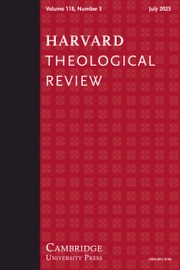No CrossRef data available.
Article contents
THE RECENTLY PUBLISHED GOSPEL OF THE SAVIOR (“UNBEKANNTES BERLINER EVANGELIUM”): RIGHTING THE ORDER OF PAGES AND EVENTS
Published online by Cambridge University Press: 21 May 2002
Extract
The most recent addition to the corpus of ancient Christian gospels first became known to scholars from a lecture presented by Charles W. Hedrick at the Sixth International Congress of Coptic Studies in 1996.Charles W. Hedrick, “A Preliminary Report on Coptic Codex P.Berol. Inv. 22220,” in Ägypten und Nubien in spätantiker und christlicher Zeit. Akten des 6. Internationalen Koptologenkongresses, Münster, 20.–26. Juli 1996, vol. 2: Schrifttum, Sprache und Gedankenwelt (ed. Stephen Emmel, Martin Krause, Siegfried G. Richter, and Sophia Schaten; Sprachen und Kulturen des Christlichen Orients 6.2; Wiesbaden: Reichert, 1999) 127–30. Some months later, the international press took a brief interest in the subject: see, for instance, Sächsische Zeitung, 15–16 March 1997, p. 33; Der kleine Bund (Bern), 14 June 1997, pp. 3–4 (article by Ulrich Luz). Three years later, the new text became available in a critical and photographic edition together with an accompanying English translation and commentary by Hedrick, in collaboration with Paul A. Mirecki,Charles W. Hedrick and Paul A. Mirecki, Gospel of the Savior: A New Ancient Gospel (Santa Rosa: Polebridge, 1999); hereafter: HM or editio princeps. and in a German translation by Hans-Martin Schenke that included his own observations on the text.Hans-Martin Schenke, “Das sogenannte ‘Unbekannte Berliner Evangelium’ (UBE),” ZAC 2 (1998) 199–213 (this is the text of the 1998 Alexander Böhlig Memorial Lecture, Halle). Schenke, who called the newly recovered work the “Unknown Berlin Gospel” because the manuscript belongs to the Berlin Papyrussammlung,Ägyptisches Museum der Staatlichen Museen Preussischer Kulturbesitz, P.Berol. inv. 22220. Schenke's abbreviation for the new gospel is UBE. had become familiar with the text when asked by Hedrick to make comments on a nearly finished draft of his edition and translation.Schenke, “Unbekanntes Berliner Evangelium,” 199–200; compare HM, vi, where it is also stated that Hedrick was primarily responsible for the transcription and translation, and Mirecki for the commentary and indexes, but that the whole work was collaborative, with both being responsible for the introduction. At that time, the American editors were referring to the new work as “A Forgotten Gospel, Fragments of an Unidentified Gospel Text,”As reported by Schenke, “Unbekanntes Berliner Evangelium,” 200. whereas in their published edition they have entitled it the Gospel of the Savior,On the assignment of this title to the work, see HM, 16–17. which I abbreviate here as Gos. Sav.Modelled on the internationally recognized English abbreviations for the works in the Nag Hammadi codices and related literature: see The Facsimile Edition of the Nag Hammadi Codices: Introduction (Leiden: Brill, 1984) 96–100; or, see HTR 80 (1987) 253.
Information
- Type
- Research Article
- Information
- Copyright
- © 2002 Cambridge University Press

